Where To Buy Stretcher Bars For Paintings Near Me
Today I'thou going to have you through the procedure that I apply to make my canvases. As I've mentioned in an before article on improving compositions, choosing the correct size and crop of your artwork is extremely important.

Quick annunciation - EmptyEasel has created a quicker, easier way for artists to have their own art website. Click here to learn more and get a simple art website of your ain!
If you're a painter, the only way to really practise that is to stretch your ain canvas to the shape and size you want.
I use materials and tools that anyone can discover at their local hardware store, and often brand big canvases for a tiny fraction of the price that it would toll me to buy them already made.

The inner frame, or structure, of every canvas I create is made out of 1×ii wood, and quarter-circular trim.
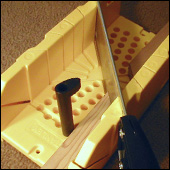
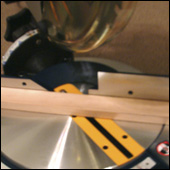
Once I've decided on the size that I want my canvass to be, I cut four pieces of 1x2s (ane for each side of the canvas), with a xl-five degree angle at each end.
You tin can use a miter box and manus saw, or power tools—either style works just fine. The virtually of import thing is to brand adept, equal, 45 caste cuts at each cease so that the wood fits together properly at the corners.
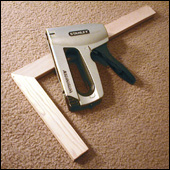 One cutting of the saw actually creates an entire corner, as you can meet in the picture to the left.
One cutting of the saw actually creates an entire corner, as you can meet in the picture to the left.
I use a simple paw-powered staple gun to secure the corners together, and normally place 3 staples on both front and dorsum of the joint.
With 6 staples fastening each corner, the entire frame becomes very stiff and rigid.

Once all four corners are stapled the frame might wait complete, just it'south really non.
You lot see, when stretching canvas, it'south important to keep information technology raised off of the frame.
That's why I go to the trouble of cutting quarter-round trim pieces as well, to make a lip, or edge, that runs along the unabridged outside border of the frame.
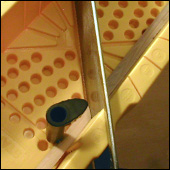
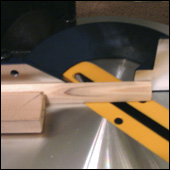
You tin cut the trim pieces with whatever tool yous used on the other pieces of woods.
Nonetheless, you may prefer to use a miter box instead of a power tool for them.
The trim pieces are so sparse that if you practise use a power saw, brace the trim piece with another piece of wood so that your fingers don't have to be anywhere close to the blade when cut.
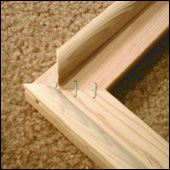 Unlike the 1x2s, a single cut with the saw does not brand a perfect corner out of 2 trim pieces. It will always be necessary to take i piece dorsum and cut off some other modest corporeality to get the right angle.
Unlike the 1x2s, a single cut with the saw does not brand a perfect corner out of 2 trim pieces. It will always be necessary to take i piece dorsum and cut off some other modest corporeality to get the right angle.
I like to lay a long slice down and marking just once where my side by side cut is, and then repeat that process again for the next side of the frame, and again, until you accept all the trim pieces you need.
Cutting all your pieces at one time doesn't ordinarily work out and so well since the angles to cut on the quarter-rounds are trickier than on the 1x2s.
To create a raised lip or edge, you'll need to place one flat side of the quarter-round against the stretcher bars, and the other flat side facing outward. The curved border of the quarter-rounds should be facing in toward the center of the frame.
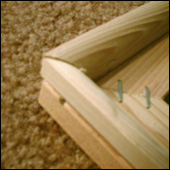 In the picture to the left you can see what a corner should look like when all the pieces have been correctly cut and aligned.
In the picture to the left you can see what a corner should look like when all the pieces have been correctly cut and aligned.
At this signal, all that's needed is to fasten the quarter-rounds permanently in identify. The best way to do that is to nail them to the frame with headless nails. The ones I use come in a package labeled "wire brads" merely finishing nails would work as well.
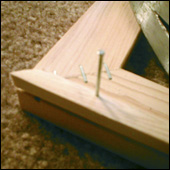 Brand sure to buy nails that are no longer than the width of your quarter-circular and i×2 combined, and space them along the trim pieces about every 4 inches, or until it's solidly in place.
Brand sure to buy nails that are no longer than the width of your quarter-circular and i×2 combined, and space them along the trim pieces about every 4 inches, or until it's solidly in place.
When the entire frame is finished, it'due south time to offset stretching the canvas. You lot'll need a rectangular piece of sheet larger than the size of your stretcher bars, plus the staple gun you used on the corners before.
From the diagram below, y'all can encounter the proper method of attaching the sail, but I won't go in-depth on that hither. Instead, take a look at my canvass stretching tutorial.
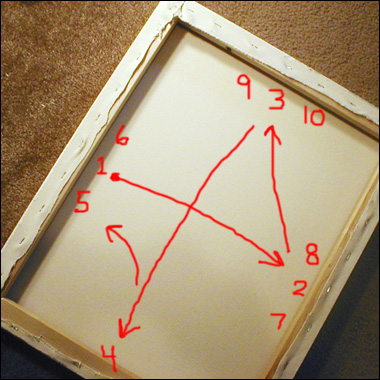
It tin be quite a workout if y'all really want a tightly stretched canvas, but it's worth it in the end. A skilful canvas should most sound similar a pulsate when yous rap your fingers confronting the front of it after information technology's all done.
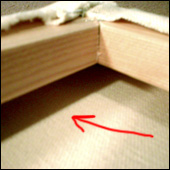 The quarter-round pieces will heighten the canvas off of the stretcher bars. If you've ever used cheap canvases, you may have felt the edge of the wood stretcher bars through the canvas from the front end, or fifty-fifty painted near the edge and had different types of brush strokes occur from hitting the wood behind information technology.
The quarter-round pieces will heighten the canvas off of the stretcher bars. If you've ever used cheap canvases, you may have felt the edge of the wood stretcher bars through the canvas from the front end, or fifty-fifty painted near the edge and had different types of brush strokes occur from hitting the wood behind information technology.
Here, the unabridged front end face of the canvas has the aforementioned feeling, from the center to the edge.
Although there are other solutions for creating canvases, this is the one I've chosen because information technology'southward piece of cake for me to practice and it's cheaper to buy all the parts separately.
So at present if yous e'er go the urge to paint a canvass in a size or shape that the store don't have; just pick up some wood, a saw and some canvas, and make your ain.
Yous might never want to pay for a pre-made canvass once again.
(PS, when you're ready to get your paintings online in front of potential buyers, check out Hands Complimentary Creative person Websites, EmptyEasel'due south new website service for artists that does all the work for you, and lets You get back in the studio.)

NOTE: Y'all may also be interested in EE'southward step-by-stride cartoon guide for artists. Click below to learn more!
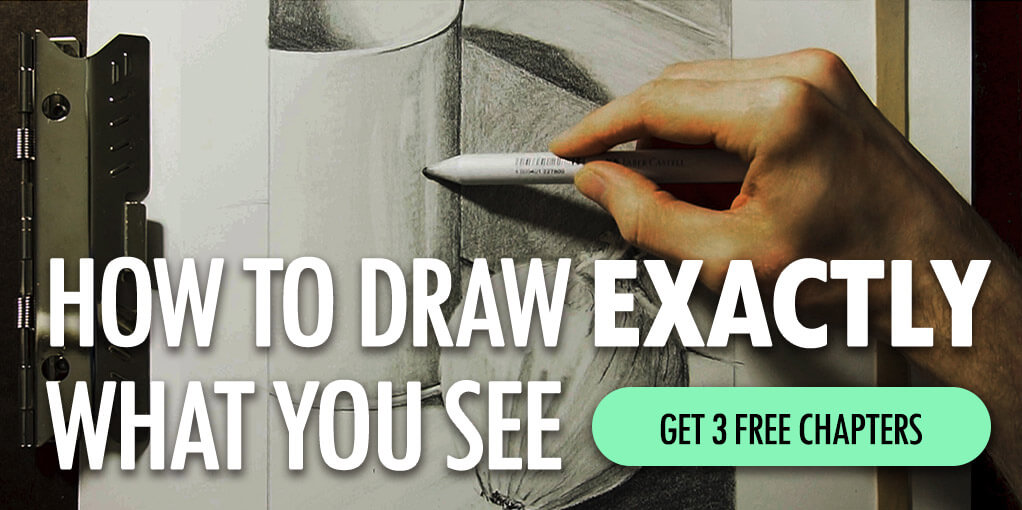
This post may comprise affiliate links.
Where To Buy Stretcher Bars For Paintings Near Me,
Source: https://emptyeasel.com/2006/12/29/how-to-make-your-own-stretched-canvases-for-painting/
Posted by: barstowfrally1974.blogspot.com


0 Response to "Where To Buy Stretcher Bars For Paintings Near Me"
Post a Comment